Sunday, February 15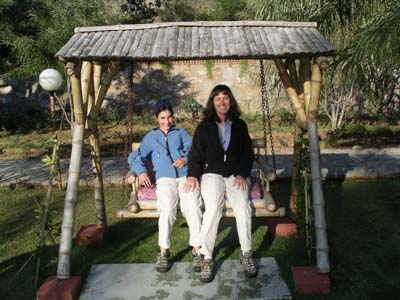
Paula: We awoke to the sounds of many birds and after showers decided to take a walk around the gardens of our small 6-room resort in Saiwar. Our host had explained last night that the fragrance from the many fruit trees has healing properties that make the brain stronger and memories vivid. The memories of today are guaranteed to be remembered for a lifetime.
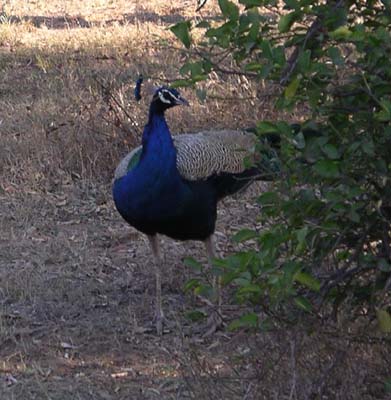 We
enjoyed the walk and especially the fresh air, clear blue sky and sounds of
the birds. We tried to sneak up on several peacocks but found them a bit shy
and quite quick on their feet. This is a common bird in India and we have
seen many. After breakfast, Utpal and a local guide accompanied us into the
village of Saiwar to visit a school. As we entered the village, we could hear
chanting and music. Utpal explained that the residents take turns maintaining
a chant to "Rama" (meaning God in Hindi) contin
We
enjoyed the walk and especially the fresh air, clear blue sky and sounds of
the birds. We tried to sneak up on several peacocks but found them a bit shy
and quite quick on their feet. This is a common bird in India and we have
seen many. After breakfast, Utpal and a local guide accompanied us into the
village of Saiwar to visit a school. As we entered the village, we could hear
chanting and music. Utpal explained that the residents take turns maintaining
a chant to "Rama" (meaning God in Hindi) contin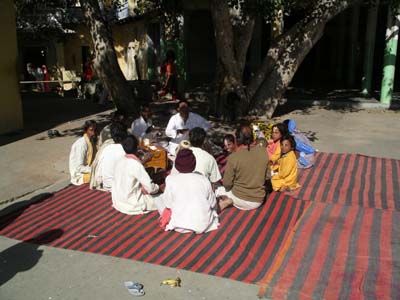 uously
- literally 24 hours a day, 7 days a week. The group gathered this morning
included 8-10 people of all ages including women and children. They seemed
to delight in our interest and allowed us to photograph and video tape their
chanting. We also entered the small temple in the village where people were
making prayers to a Hindu God. We are slowly learning about Hinduism and its
many Gods and rituals. As we made our way to the school, several men and women
stopped to talk to us and seemed interested in who we were. The women frequently
would come quite close to Katie and me, often touching us and speaking in
Hindi. Their genuine warmth was evident and I never felt uncomfortable during
these encounters. They seem to be interested in our fair skin, clothing and
height. At 5 feet 5 inches, I have never felt tall until now!
uously
- literally 24 hours a day, 7 days a week. The group gathered this morning
included 8-10 people of all ages including women and children. They seemed
to delight in our interest and allowed us to photograph and video tape their
chanting. We also entered the small temple in the village where people were
making prayers to a Hindu God. We are slowly learning about Hinduism and its
many Gods and rituals. As we made our way to the school, several men and women
stopped to talk to us and seemed interested in who we were. The women frequently
would come quite close to Katie and me, often touching us and speaking in
Hindi. Their genuine warmth was evident and I never felt uncomfortable during
these encounters. They seem to be interested in our fair skin, clothing and
height. At 5 feet 5 inches, I have never felt tall until now!
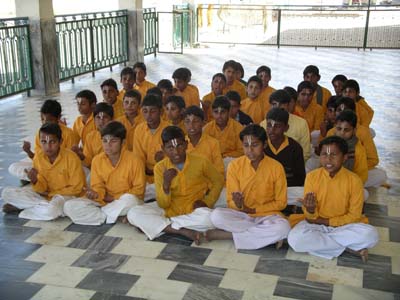 When
we reached the school, we found the children filing into a small open air
porch preparing to greet us. They sat on the floor in rows wearing bright
orange and yellow shirts. Their foreheads were marked with white and red lines
(made from sandalwood paste) and have learned that the markings individuals
in India are an indication of blessings. The Vedic School has about 100 children
who live in the ashram run by the Holy Highness Maharaj Narain Dass Ji. The
children are educated in Vedic studies (the Hindu scriptures), Indian cultural
heritage and Hindi. We learned that these children (almost all boys) are ages
10-16 and are being trained to become priests. The
When
we reached the school, we found the children filing into a small open air
porch preparing to greet us. They sat on the floor in rows wearing bright
orange and yellow shirts. Their foreheads were marked with white and red lines
(made from sandalwood paste) and have learned that the markings individuals
in India are an indication of blessings. The Vedic School has about 100 children
who live in the ashram run by the Holy Highness Maharaj Narain Dass Ji. The
children are educated in Vedic studies (the Hindu scriptures), Indian cultural
heritage and Hindi. We learned that these children (almost all boys) are ages
10-16 and are being trained to become priests. The 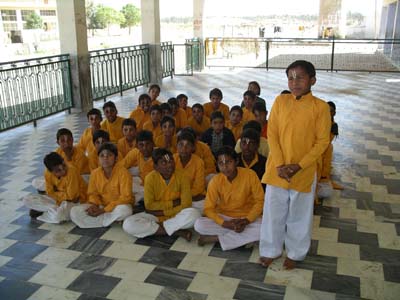 children
performed several of the 2,000 chants that they are expected to learn during
the course of their 6 years of studies here.
children
performed several of the 2,000 chants that they are expected to learn during
the course of their 6 years of studies here.
Afterwards, we had fun question and answer session with the students. First,
David and Katie asked how long they study each day and we were amazed to 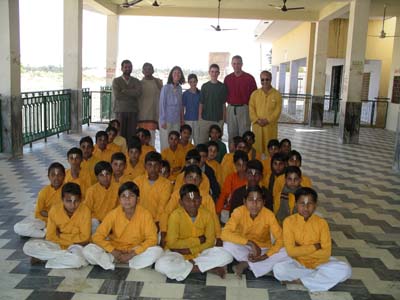 find
out that their school day goes from 4:00AM until 6:00PM. Although shy at first,
one of the young men asked us where we were from and what the most important
city in America was. We also asked how many Americans they had met and were
surprised to find that we were the first Americans any of them had ever spoken
to. As we spent more
find
out that their school day goes from 4:00AM until 6:00PM. Although shy at first,
one of the young men asked us where we were from and what the most important
city in America was. We also asked how many Americans they had met and were
surprised to find that we were the first Americans any of them had ever spoken
to. As we spent more 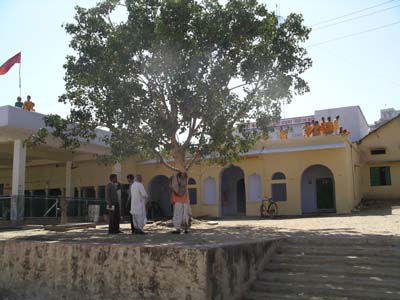 time
with the boys, they clearly became more comfortable with us and were smiling
and laughing to themselves, especially as we started trying to communicate
with each other.
time
with the boys, they clearly became more comfortable with us and were smiling
and laughing to themselves, especially as we started trying to communicate
with each other.
We then had a brief photo session where we took pictures of the group, and
were surprised to also find that the school had arranged for a local photographer
to come and take a picture of us all. Apparently, we're going to be in their
magazine! This was a very unique experience, and the fact that we were the
first Americans to come here made us feel very special. The boys continued
to smile, laugh and wave to us from the roof of the school until we were out
of sight. 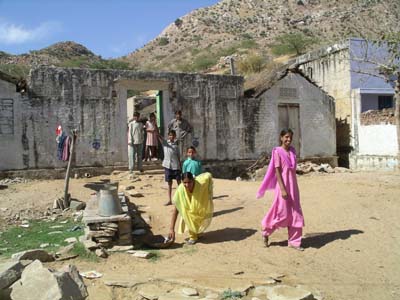
We continued our tour of the village by visiting a local home. Utpal explained
that in India families always welcome unexpected guests because the Hindu
religion teaches that brings them good karma. In nearly 20 years, Utpal can
only remember one time when a family did not welcome him and his guests into
their home (never in America!). We experienced this openness first hand as
Utpal picked a modest-looking home, walked to the front door, and quickly
motioned for us to join him. We couldn't believe the hospitality shown to
us from this obviously poor family. They immediately gathered around us, found
us chairs and brought us each a drink (which we had to politely refuse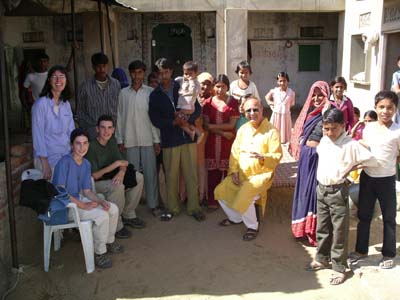 ).
Utpal quickly got to know the family and explained where we were from. This
very simple open structure was home for an extended family that included a
grandmother, grandfather and their 4 sons, their wives and children. There
was no electricity or running water, and the bare ground served as the floor.
The family owns a plot of barren land near the home where they maintain a
herd of 100 goats and sheep. The 15 year-old grandson spoke some English and
acted as the spokesperson. As we met with the family, several curious neighbors
stopped by to join our conversation - everyone was genuinely warm and friendly.
The weathered hands and faces of the grandparents and the sparkling eyes and
bright smiles of the beautiful young women will be something we will never
forget.
).
Utpal quickly got to know the family and explained where we were from. This
very simple open structure was home for an extended family that included a
grandmother, grandfather and their 4 sons, their wives and children. There
was no electricity or running water, and the bare ground served as the floor.
The family owns a plot of barren land near the home where they maintain a
herd of 100 goats and sheep. The 15 year-old grandson spoke some English and
acted as the spokesperson. As we met with the family, several curious neighbors
stopped by to join our conversation - everyone was genuinely warm and friendly.
The weathered hands and faces of the grandparents and the sparkling eyes and
bright smiles of the beautiful young women will be something we will never
forget.
Although the home's living conditions were very poor (by Western standards), we were struck by the genuine sense of joy conveyed by the family. The laughter, smiles and warmth we felt from these people taught us all something about what's really required in life for happiness.
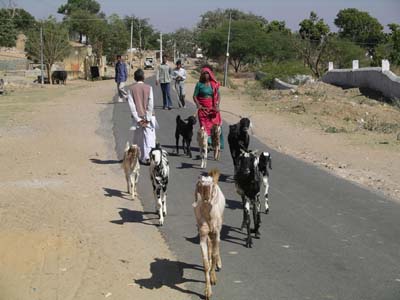 As
we left the village to return back to our resort for lunch, we were followed
by many of the villagers and it was clear that they were as curious about
us as we were about them. We spoke with Utpal at lunch about the condition
of this family. He classified them as a poor family, with only minimal income
from their herd of sheep and goat. We wondered about the opportunities for
the young people of a family like this. Utpal indicated that he was pleased
to see that the children were going to school and indicated that one of the
top students at the Indian Institute of Technology is from a village in Rajasthan.
While the opportunity exists, the reality is that only a small percentage
of these young people will ever leave their villages.
As
we left the village to return back to our resort for lunch, we were followed
by many of the villagers and it was clear that they were as curious about
us as we were about them. We spoke with Utpal at lunch about the condition
of this family. He classified them as a poor family, with only minimal income
from their herd of sheep and goat. We wondered about the opportunities for
the young people of a family like this. Utpal indicated that he was pleased
to see that the children were going to school and indicated that one of the
top students at the Indian Institute of Technology is from a village in Rajasthan.
While the opportunity exists, the reality is that only a small percentage
of these young people will ever leave their villages.
After lunch, we drove about 60 km to Jaipur. Before leaving the resort of
Saiwar Bagh, we were asked to sign their guest book. We had to laugh as Steve
signed the book with at least 15 Indian guests at the resort (attending a
wedding there) looked on. We teased that he looked like an honorary official
signing an important document. It seems we will just have to get used to being
a spectacle at least while we are here in India.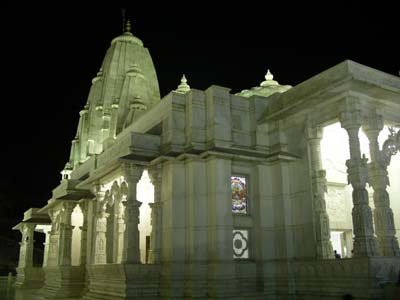
The drive to Jaipur seemed easy after the much longer drive yesterday. We
checked into our hotel which was a haveli (mansion) built in 1728 to administer
the security of the Raj (king) that time. It will be interesting to stay in
the old mansion over the next several days as we explore this beautiful city.
Jaipur is the capital of Rajasthan and the first planned city in India. For
the first time, we began seeing traffic lights that were functioning, sidewalks
and more modern shops and apartments. The city is called the "pink city"
because all the walls are a terra cotta color. This brings uniformity and
warmth to the town. 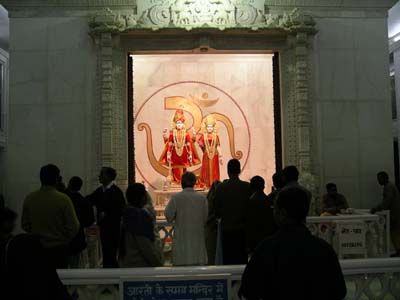
In the evening we visited the Birla Temple, a beautiful Hindu structure built in 1985. This white marble structure sits atop a small hill and was clearly a meeting spot for the community. We joined many finely dressed Indian families visiting to say prayers to the Hindu Gods of life. Utpal explained some the Hindu mythological stories that were displayed in the marble of the temple's panels.
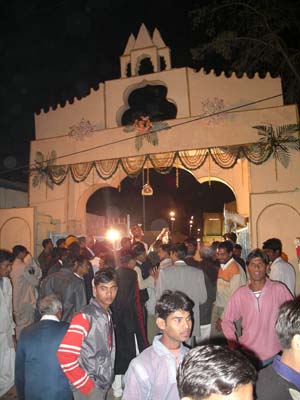 On
our way back to the hotel for dinner, we noticed a wedding party gathered
along the road. Utpal stopped our driver and before we knew it, we had an
invitation to join in the party. We saw the groom arriving on a white horse
with a band playing to announce his entry. There were hundreds of guests all
being feed a wonderful dinner. One well-dressed man saw us watching from the
rear and quickly came to greet us and invite us to eat. Again, we were amazed
at this hospitality - here were these foreigners who walked into a wedding
party and were now being invited to join in the food and
On
our way back to the hotel for dinner, we noticed a wedding party gathered
along the road. Utpal stopped our driver and before we knew it, we had an
invitation to join in the party. We saw the groom arriving on a white horse
with a band playing to announce his entry. There were hundreds of guests all
being feed a wonderful dinner. One well-dressed man saw us watching from the
rear and quickly came to greet us and invite us to eat. Again, we were amazed
at this hospitality - here were these foreigners who walked into a wedding
party and were now being invited to join in the food and 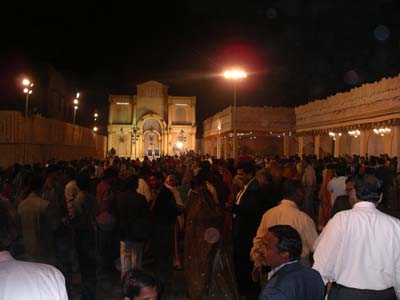 festivities!
The man wanted to know where we were from and indicated he had visited many
American cities on business. The children at the wedding were also curious
and several small boys finally came up to David and asked where we were from.
They even managed to ask in English if we had coins to exchange - American
for Indian. As left the wedding, we couldn't help but think that this would
never happen in America.
festivities!
The man wanted to know where we were from and indicated he had visited many
American cities on business. The children at the wedding were also curious
and several small boys finally came up to David and asked where we were from.
They even managed to ask in English if we had coins to exchange - American
for Indian. As left the wedding, we couldn't help but think that this would
never happen in America.
We are looking forward to exploring more of Jaipur tomorrow including the
city observatory, fort, palace and colorful market.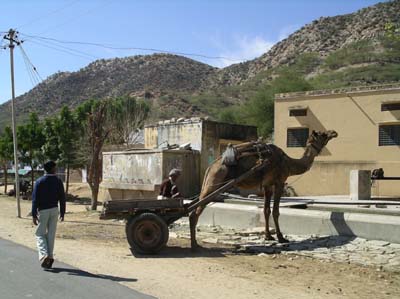
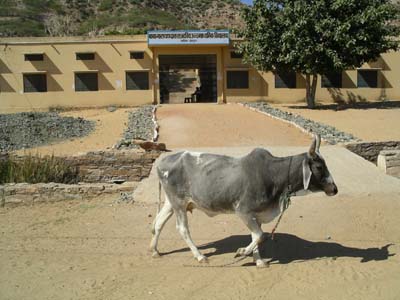
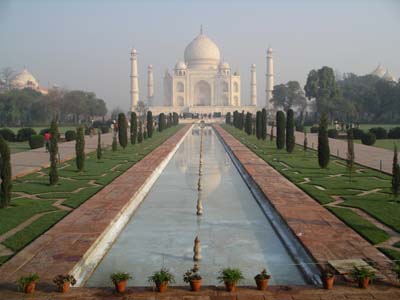
Katie's Kwick Kwacks: The Taj Mahal. This week we visited the world famous Taj Mahal, regarded as one of the most beautiful buildings on earth. This amazing mausoleum located in Agra, was built by Emperor Shah Jahan in memory of his wife who died in childbirth in the year 1631. The construction of the Taj Mahal began the same year and ended in 1653. A total of 20,000 people worked on the project (including those who brought marble, etc.) The construction of this monumental love building was so important, that many of the workers' hands and fingers were amputated to ensure the architectural skill of the Taj could not be repeated.
Because of the emperor's dear love and affection for his wife, the architecture
of the Taj Mahal is very romantic and dreamy, the design simple and peaceful.
The complex is made up of the main building, two buildings on either side
of the main structure, and some beautiful gardens in front. The main building
is coated in white marble and made up of three domes, along with two large
minarets beside them. It is coated in many decorations, including Arabic verses
of the Koran. The two buildings beside this one serve as a museum and mosque.
The gardens in front of these three structures are positively beautiful, with
a small river lined by 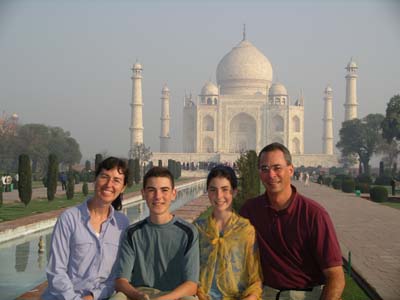 lovely
cypress trees and flowers, representing love and death. As you move closer
to the main mausoleum, you begin to realize just how large the Taj Mahal really
is. Inside of the Taj Mahal are the tombs of the emperor's wife and the emperor
himself. The internal decorations and carvings are those of flowers and hearts,
and the simplicity of it gives the structure a warm and peaceful atmosphere.
lovely
cypress trees and flowers, representing love and death. As you move closer
to the main mausoleum, you begin to realize just how large the Taj Mahal really
is. Inside of the Taj Mahal are the tombs of the emperor's wife and the emperor
himself. The internal decorations and carvings are those of flowers and hearts,
and the simplicity of it gives the structure a warm and peaceful atmosphere.
The beauty of the Taj Mahal simply cannot be put into words. Although I have seen many pictures of the Taj Mahal, nothing could really prepare for seeing it in person. The overall scene of getting a first glimpse of it through the gate, and being in the midst of its peaceful atmosphere is unexplainable. In short, to the only way to fully understand the Taj Mahal's beauty and significance is by not only seeing it, but more importantly being a part of it.
